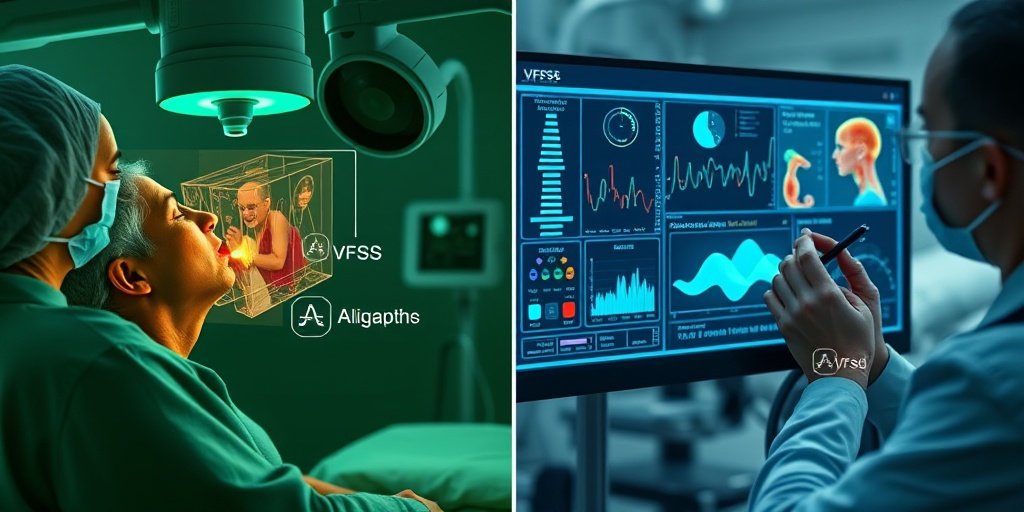⚡ Quick Summary
This comprehensive review explores the role of artificial intelligence (AI) in analyzing Videofluoroscopic Swallowing Studies (VFSS), which are crucial for diagnosing swallowing disorders. Despite significant advancements in AI applications, an end-to-end automated tool for VFSS analysis remains to be developed.
🔍 Key Details
- 📊 Focus: Artificial Intelligence in VFSS analysis
- 🧩 Key Areas: Pharyngeal phase detection, bolus segmentation, penetration-aspiration detection
- ⚙️ Current Status: No complete automated AI tool available yet
- 🏆 Research Limitations: Lack of publicly available datasets, generalizability issues
🔑 Key Takeaways
- 📊 VFSS is the gold standard for diagnosing dysphagia.
- 💡 AI shows promise in enhancing the accuracy of VFSS interpretation.
- 👩🔬 Progress has been made in pharyngeal phase detection and bolus identification.
- 🏥 Clinical relevance of segmented components needs further exploration.
- 🌍 AI integration could expand to include more upper aerodigestive components.
- 🛠️ Limitations include the need for better datasets and model generalizability.
- 📈 Future research should focus on developing automated tools for clinical use.

📚 Background
Dysphagia, or swallowing disorders, can significantly impact a person’s quality of life. The Videofluoroscopic Swallowing Study (VFSS) is widely regarded as the most reliable method for diagnosing these disorders. However, the interpretation of VFSS results can be influenced by human bias, leading to variability in diagnoses. This is where artificial intelligence steps in, offering the potential to standardize and enhance the analysis process.
🗒️ Study
The review conducted by Sanjeevi et al. focuses on the latest advancements in AI technologies applied to VFSS analysis. It highlights various studies that have utilized AI for tasks such as detecting the pharyngeal phase of swallowing and identifying critical anatomical structures involved in the swallowing process. The authors emphasize the need for further research to develop a comprehensive automated AI tool that can be used in clinical settings.
📈 Results
The analysis reveals substantial progress in AI applications for VFSS, particularly in areas like segmentation and penetration-aspiration detection. However, the authors note that despite these advancements, a fully automated AI tool for VFSS analysis has not yet been realized. This indicates a gap in the current research landscape that needs to be addressed.
🌍 Impact and Implications
The integration of AI into VFSS analysis could revolutionize the diagnosis and management of swallowing disorders. By reducing human bias and increasing the accuracy of assessments, AI has the potential to improve patient outcomes significantly. Furthermore, expanding the scope of AI applications to include more components of the upper aerodigestive tract could enhance our understanding and treatment of related disorders.
🔮 Conclusion
This review underscores the transformative potential of artificial intelligence in the field of dysphagia diagnosis. While significant strides have been made, the development of an end-to-end automated AI tool remains a critical goal for future research. Continued exploration in this area promises to enhance clinical decision-making and improve patient care in swallowing disorders.
💬 Your comments
What are your thoughts on the integration of AI in analyzing swallowing disorders? We would love to hear your insights! 💬 Join the conversation in the comments below or connect with us on social media:
Artificial Intelligence in Videofluoroscopy Swallow Study Analysis: A Comprehensive Review.
Abstract
Videofluoroscopic Swallowing Study (VFSS) is considered the gold standard for diagnosing swallowing disorders, or dysphagia. However, the interpretation of VFSS is susceptible to human bias and subjectivity, resulting in significant inter- and intra-patient variability. In this context, artificial intelligence (AI) has emerged as a potentially valuable tool for physicians. This study reviews state-of-the-art research utilizing AI to analyze VFSS for the assessment of swallowing disorders and to support clinical decision-making. Our comprehensive analysis highlights substantial progress in areas such as pharyngeal phase detection, segmentation and identification of the bolus and hyoid bone, and penetration-aspiration detection. Despite these advancements, an end-to-end automated AI tool for VFSS analysis has yet to be developed. However, there is considerable potential for AI applications in areas like exploring the clinical relevance of segmented or tracked components and expanding the scope to include more upper aerodigestive components in the analysis. Additionally, we discuss the limitations of current research, including the lack of publicly available datasets, the need to address the generalizability of AI models, the integration of cutting-edge AI techniques, and the clinical implications for speech-language pathologists.
Author: [‘Sanjeevi G’, ‘Gopalakrishnan U’, ‘Pathinarupothi RK’, ‘Iyer KS’]
Journal: Dysphagia
Citation: Sanjeevi G, et al. Artificial Intelligence in Videofluoroscopy Swallow Study Analysis: A Comprehensive Review. Artificial Intelligence in Videofluoroscopy Swallow Study Analysis: A Comprehensive Review. 2025; (unknown volume):(unknown pages). doi: 10.1007/s00455-025-10812-8